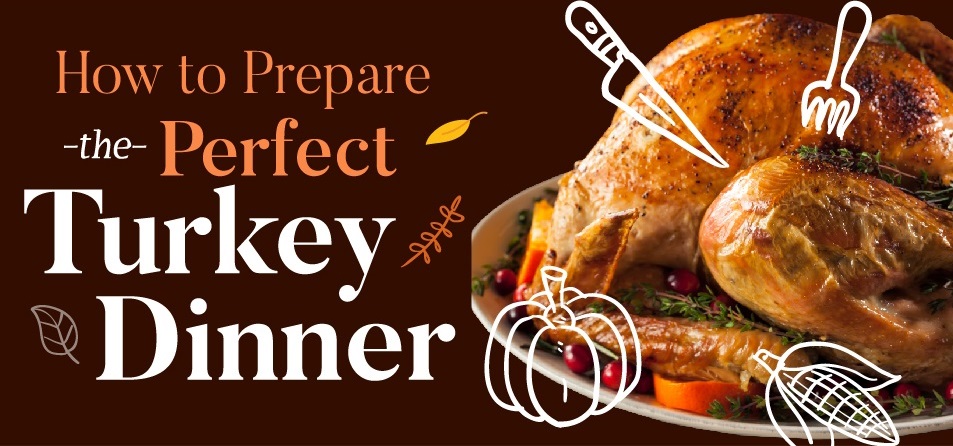
With Thanksgiving right around the corner, many home cooks are wondering how to cook a turkey that will please everyone at their holiday table. From figuring out how to season a turkey to determining how long to cook it, how to carve it and the best way to serve it, a lot goes into creating the perfect turkey dinner.
Luckily, we’ve put together some tips and tricks that explain how to roast a turkey successfully. If you follow our advice, you won’t have any problems preparing a turkey feast that will be a hit with everyone at your table. The only thing you may struggle with is keeping up with all of the requests for more of your scrumptious food.

Choosing Your Turkey: Fresh or Frozen?
Choosing a turkey is a decision that plagues many home cooks around the holidays, but it doesn’t have to be an agonizing choice. You really can’t go wrong with any turkey you decide to buy because it’s an incredibly versatile, tasty protein.
The first step toward choosing a turkey is to decide whether you’re going to purchase a fresh or frozen bird. There are advantages and disadvantages to buying fresh and frozen turkeys, so let’s take a quick look at some of them.
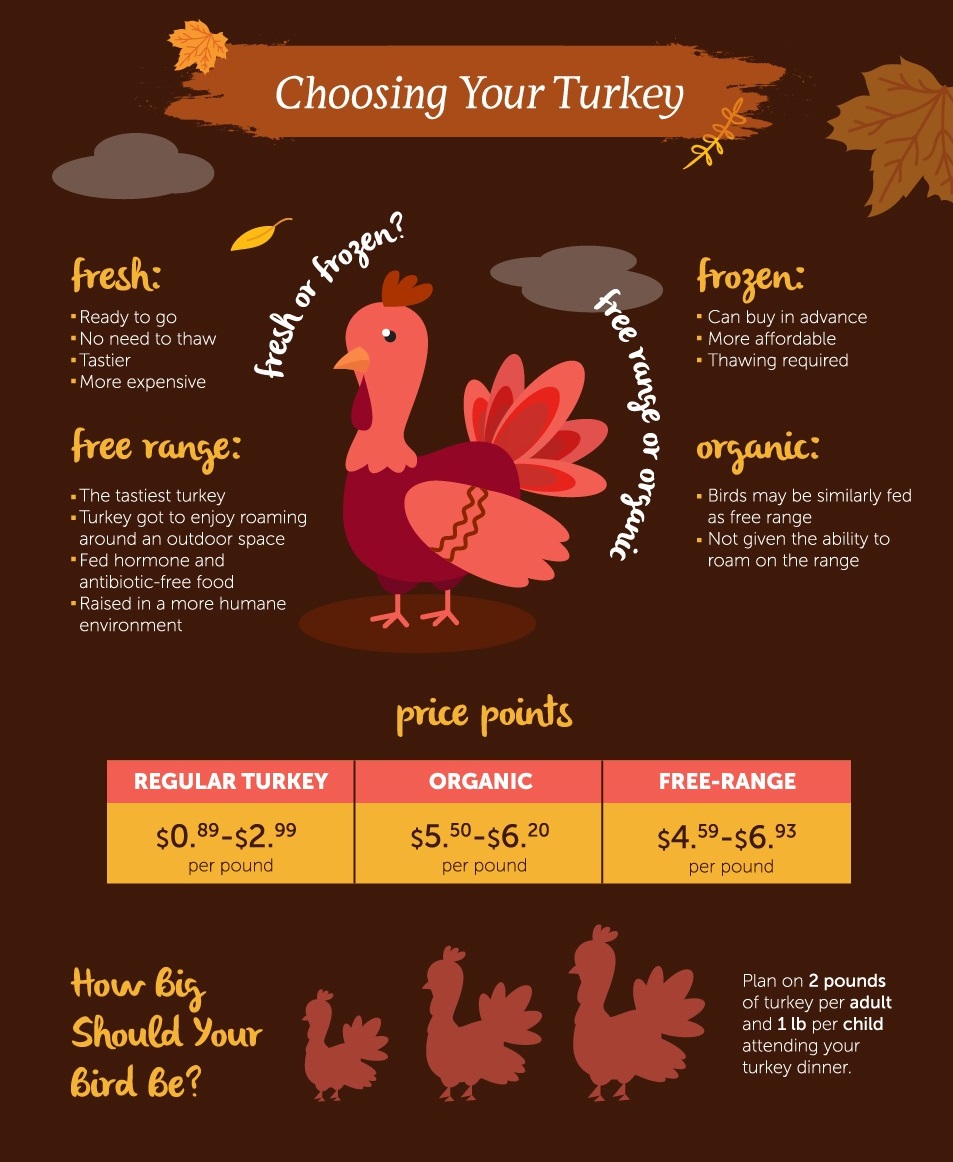
Fresh
A fresh turkey is ready to go into the oven without the need to thaw it. Fresh turkeys are typically tastier than their frozen brethren, too. That added taste comes at a price, however, as fresh turkeys are normally more expensive than frozen.
Frozen
If you know your schedule is going to be tight around Thanksgiving, you may want to get a frozen turkey because you can buy it well in advance of the holiday and stow it in your freezer. In addition to being able to buy a frozen turkey in advance, you can also save some money with a frozen turkey because they’re cheaper than the fresh variety.
The most significant drawback to going the frozen route is that you’ll have to thaw your bird before you can prepare it. If you’re trying to figure out how to cook a frozen turkey, thawing will be your first step.
Free-Range or Organic?
Just like you have to choose between a fresh or frozen turkey, you’ll also need to decide if you want a free-range or organic bird if you’re not satisfied with a “regular” turkey. Similar to how there are up- and downsides to getting a fresh or frozen turkey, free-range and organic turkeys have their pluses and minuses, too.
Free-Range
Free-range turkeys are more expensive than both regular and organic turkeys. While that’s the case, many people feel free-range turkeys are worth the extra money because they’re the tastiest.
Shoppers are also willing to pay more for free-range turkeys because they take comfort in knowing these birds are raised in a more humane environment, given the chance to roam around in an outdoor space and fed hormone and antibiotic-free food.
Organic
In many cases, organic turkeys enjoy a diet that’s similar to what free-range birds eat. Organic turkeys don’t have the freedom to roam outdoors like free-range turkeys do, however.
Naturally, price will be a factor for many home cooks when they’re shopping for a turkey. If you’re going to purchase a regular turkey, meaning one that’s neither free-range nor organic, you should expect to pay anywhere from $0.89 to $2.99 per pound. An organic turkey typically costs $5.50 – $6.20 per pound, while a free-range turkey often costs $4.59 – $6.93 per pound.
How Big Should Your Bird Be?
When it comes to turkeys, size matters. You don’t want to get a bird that’s too big because you may end up with leftovers that eventually end up getting thrown out. Even worse, you don’t want to purchase a turkey that’s too small and not have enough to serve all of your hungry dinner guests.
To help you get a turkey that’s just the right size, plan on two pounds of turkey for each adult and one pound for every child who will join you for dinner. So, if 10 adults and five kids will attend your dinner, purchase a turkey that weighs 25 pounds.
Preparing and Cooking Your Turkey
Here’s how to go about getting your turkey prepared and cooked to perfection.
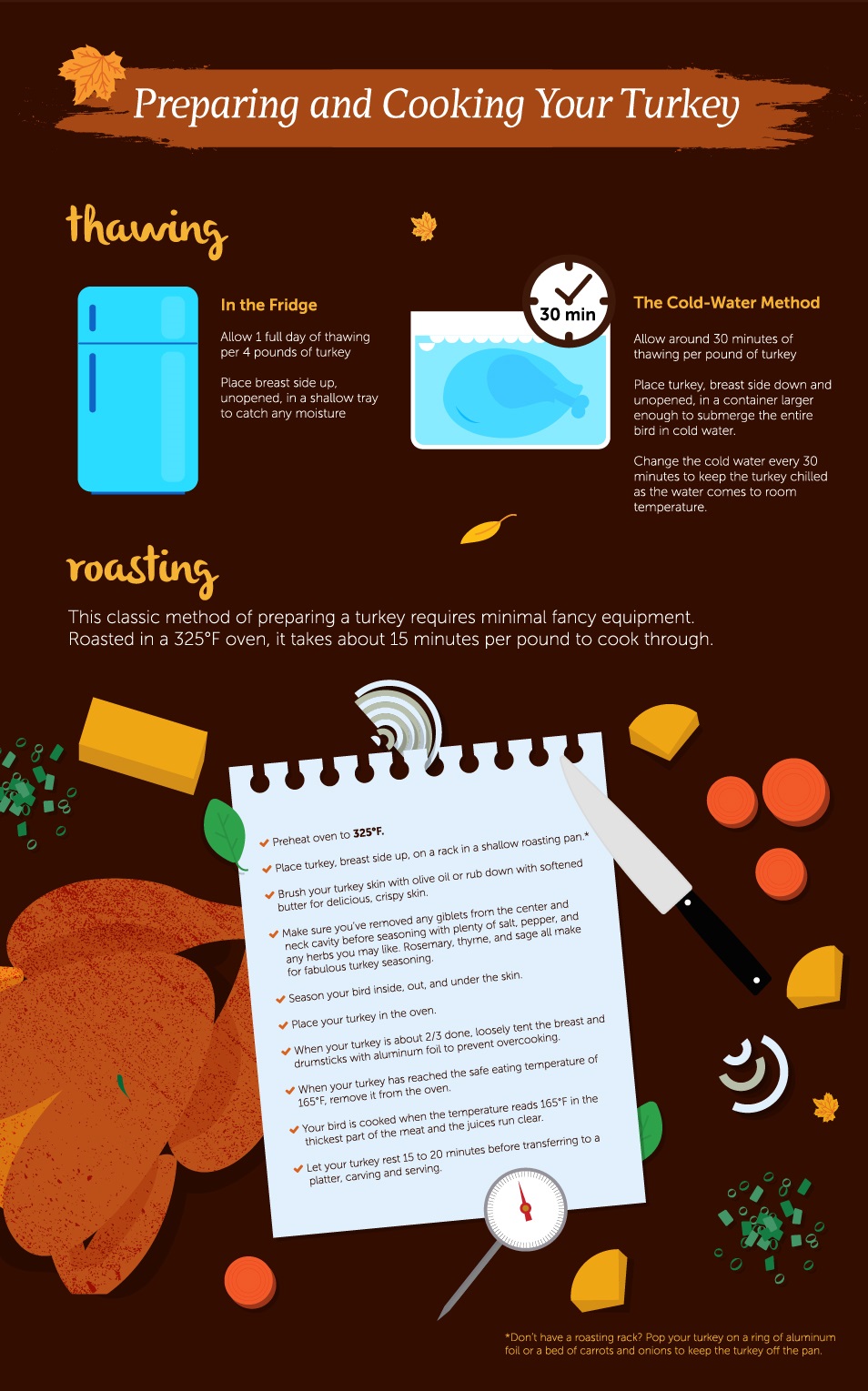
Thawing
Before you start fretting over turkey cook times, you need to get your bird ready for the oven. If you opted for a frozen turkey, begin by thawing it. Depending on the size of the turkey you have and how you plan on thawing it, you may need several days for your bird to thaw completely. Here are a couple of ways to do it:
1. In the Fridge
One popular method for thawing a turkey is in your refrigerator. Allow one full day of thawing for every four pounds of turkey. If your bird weighs 20 pounds, you should plan to leave it in your fridge for five days.
To thaw a turkey in your refrigerator, place it in a shallow pan that will catch any moisture that drips from your bird. Position your turkey so that it’s breast-side up and refrain from opening its packaging. Put the pan and turkey in the fridge.
2. The Cold-Water Method
If you’re going to employ the cold-water method for thawing, allow approximately 30 minutes per pound of turkey. Get a container that’s big enough to completely submerge your turkey in water. Fill the container with cold water and put your bird in the container, breast-side down and unopened.
If it’s easier, you can position your turkey in the container first and then fill the container with water. Either way, you’ll need to change the water in the container every 30 minutes or so to keep your bird chilled.
Regardless of the method you use to thaw your turkey, you can store your thawed bird in the refrigerator for up to four days before you cook it.
Roasting Your Turkey
If you’ve researched how long to cook a turkey, then you know cooking a stuffed bird takes longer than cooking one that’s unstuffed. You’ve also probably read that you can rely on that little white pop-up timer to tell you when your turkey is properly cooked — but you won’t want to.
Consider this fun fact about a turkey’s timer: These timers were created back in the 1960s when it was generally accepted that turkeys needed to be cooked until their internal temperature reached 180 degrees Fahrenheit. Since we now know that a turkey’s internal temperature only needs to reach 165 degrees Fahrenheit, that little timer will help you make the driest turkey around instead of the perfect turkey dinner.
Roasting is the time-tested, classic way to cook a turkey without needing fancy equipment. You’ll want your oven at 325 degrees Fahrenheit to cook your turkey, and it will take about 15 minutes per pound for your turkey to cook through.
Follow these simple steps to roast a turkey that will make everyone’s mouth water:
1. Preheat the oven to 325 degrees Fahrenheit.
2. Position your bird on a rack in a shallow roasting pan so that it sits breast-side up.
Insider’s Tip: If you don’t have a roasting pan, any pan will do. Just rest your turkey on top of a ring of aluminum foil or a bed of carrots and onions, so it isn’t sitting directly on the pan.
3. Brush your turkey’s skin with olive oil or, for crispier skin, rub it with some softened butter.
4. Double check that you removed the turkey’s giblets from its center cavity and neck, and then season your bird with generous amounts of salt, pepper and herbs. If you’re unsure what herbs to use, rosemary, thyme and sage are all great choices. Just be sure you season your entire bird, including the inside, outside and under the skin.
5. When your oven reaches 325 degrees Fahrenheit, place your turkey inside.
6. When your bird is two-thirds done, put a loose aluminum foil tent over the breast and drumsticks. This will prevent overcooking.
7. When your turkey reaches an internal temperature of 165 degrees Fahrenheit, remove the bird from the oven.
Insider’s Tip: To accurately measure your turkey’s temperature, measure the temperature in the thickest part of the meat without your thermometer touching any bones. Be sure the juices dripping from your turkey are clear before you remove it from the oven.
8. Let your turkey rest as is for 15 to 20 minutes before you transfer it to a platter. Then, carve it and serve.
To Stuff or Not to Stuff?
If you already know how long to cook a stuffed turkey, then you’re probably a fan of cooking your stuffing inside of your bird.
The biggest benefit of stuffing a turkey is that your stuffing will pick up some fantastic flavor from the turkey’s drippings. While that certainly sounds delicious, there’s a greater risk of foodborne illness when you stuff a turkey.
If you do plan on stuffing your bird, here are the steps you should follow to do it safely:
1. Only use fully-cooked stuffing to stuff your turkey.
2. Refrain from stuffing your bird the night before. Stuff your turkey right before you’re going to put it in the oven.
3. Use about one-half to two-thirds of a cup of stuffing for every pound your turkey weighs.
4. The center of your stuffing must also reach 165 degrees, just like the turkey.
5. Do not cook a stuffed turkey on a grill or in a smoker or deep fryer. Only stuff your turkey if you’re going to roast it.
Carving Your Turkey
If you thought cooking your turkey was an exciting adventure, you’re in for a treat when it’s time to carve it. While there isn’t one right way to carve a turkey, here are some turkey carving tips you can use to impress your guests:
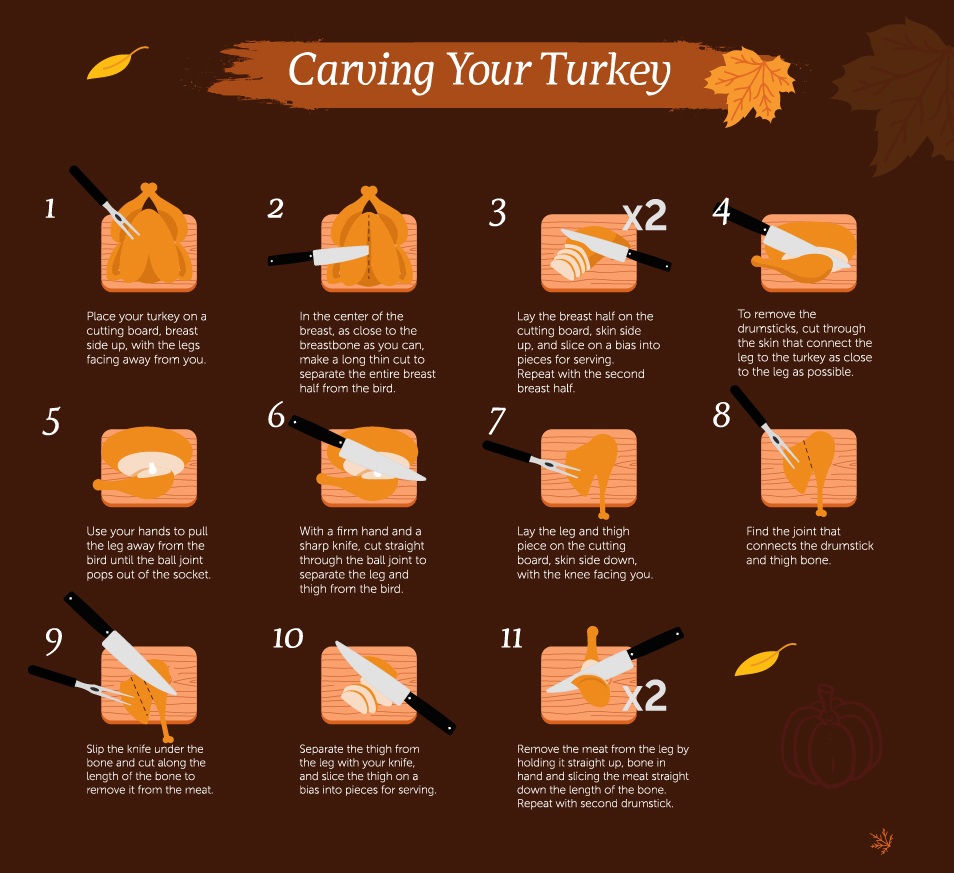
1. Put your turkey on a cutting board with its breast up and legs facing away from you.
2. Position your knife as close to the breastbone as possible in the center of the breast. Make a long, thin cut so that the entire breast half separates from the turkey.
3. Lay the breast half you just cut on your cutting board with the skin up. Cut the breast on a bias so that it’s ready to serve.
4. Repeat the same process with the breast half that’s still attached to your turkey.
5. To remove the drumsticks, slice the skin that connects the leg to the body with a cut that’s as close as possible to the leg.
6. With one hand holding the turkey in place, use your other hand to pull the leg away from the bird until the ball joint pops out of its socket.
7. Keeping a firm hand and using a sharp knife, cut the ball joint so that the leg and thigh separate from the turkey.
8. Position the leg and thigh piece on your cutting board with the skin down and the knee facing you.
9. Use your fingers to find the joint connecting the leg and thigh bone.
10. Slip your knife under that bone and cut along the length of it to remove the bone from the meat.
11. Use your knife to separate the thigh and leg. Lay the thigh on your cutting board and cut the meat on a bias to serve.
12. To remove the meat from the leg, hold the leg straight up. With the leg bone in hand, slice the meat straight down the entire length of the bone.
13. Do the same with the remaining drumstick.
Serving Your Turkey
What’s the best way to serve your mouth-watering turkey? With gravy and all the fixings, of course!
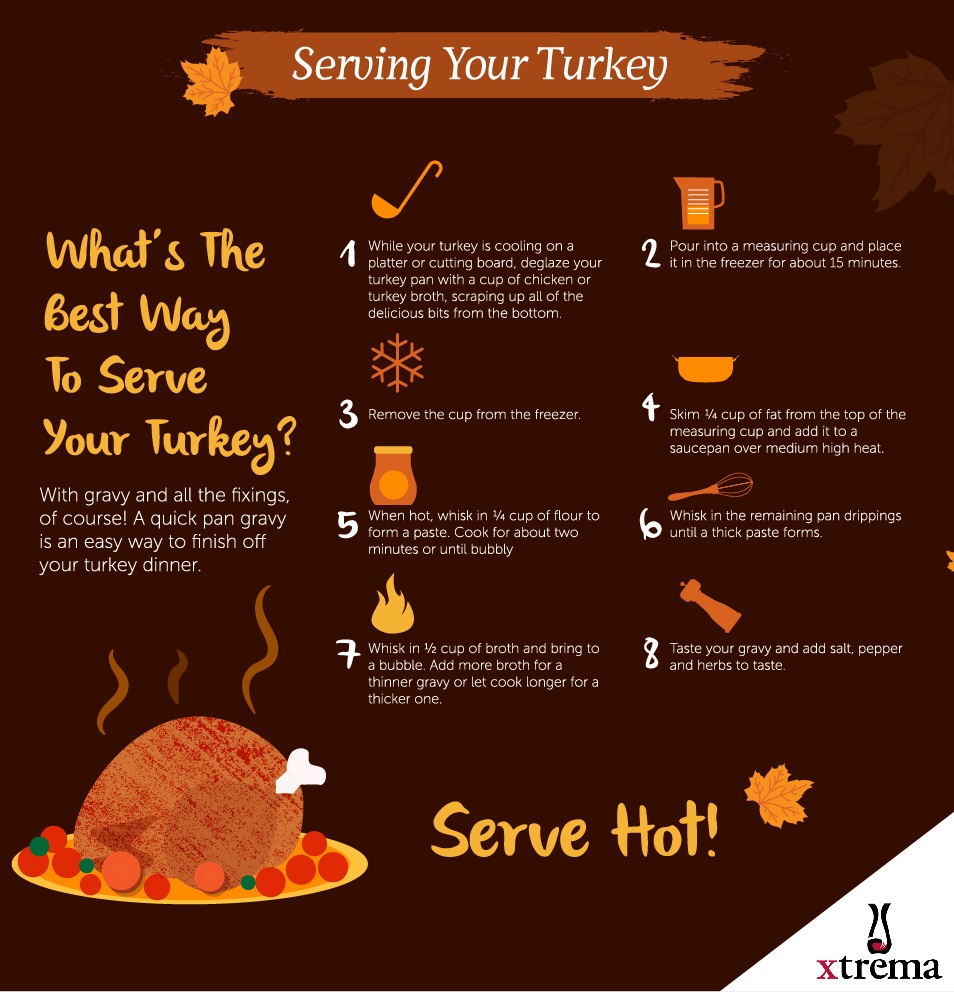
To make a gravy that will complement your turkey perfectly, follow these easy steps:
1. When your turkey is cooling on a platter or cutting board, deglaze your roasting pan with a cup of turkey or chicken broth. Scrape up all of the yummy bits from the bottom of your pan as you do this.
2. Pour the liquid in a measuring cup and put it in the freezer for about 15 minutes.
3. Remove the measuring cup from the freezer.
4. Skim ¼-cup of fat from the top of your measuring cup and put it in a sauce pan over medium-high heat.
5. When it’s hot, whisk in ¾-cup of flour to form a paste. Let the paste cook for two minutes, or until it’s bubbly.
6. Whisk the pan drippings that are still in your measuring cup into your sauce pan until the paste thickens.
7. Whisk ¾-cup of broth in with the ingredients in your sauce pan and bring the pan’s contents to a bubble. If you want a thicker gravy, let your gravy continue to cook. For a thinner gravy, add more broth to your sauce pan.
8. Taste your gravy and add salt, pepper and herbs to taste.
9. Serve hot!
Of course, preparing the perfect turkey dinner is much easier when you have the right equipment in your kitchen. Shop with Ceramcor to find what you need to pull off an unforgettable turkey dinner this year.
